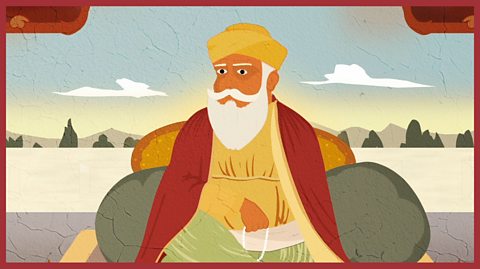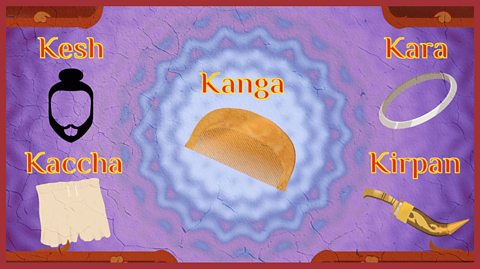±«Óătv Teach > School Radio > Assemblies > Vaisakhi
SMSC - Festivals - Calendar - Philosophical - Treasure Champs - Songs
In short...
Themes: celebrating Vaisakhi; Sikh culture and beliefs; the Khalsa; the 5 Ks.
Summary: Vaisakhi (also Baisakhi) is a spring festival which happens each year on 13 or 14 April. It celebrates the founding of the Sikh community, the Khalsa, in 1699. The assembly is most relevant at the time of Vaisakhi, but can be used at other times of year to explore Sikh culture and beliefs more generally.
Resources: The , and an illustration of .

The video
On the 13th or 14th of April, Sikhs like me, and others all over the world celebrate the festival of Vaisakhi!
It is a celebration held in the spring to mark the founding of the Sikh community - the Khalsa.
We believe in one God to guide us and believe everyone else is equal.
My religion, Sikhism, is one of the youngest world religions.
It was founded by Guru Nanak Dev in around 1500 CE when he began teaching the faith in the Punjab area of South Asia, which now covers parts of India and Pakistan.
He believed that all our actions are important, and we should be honest and generous to others.
Over the next 200 years, Nanak Dev's teachings were continued by nine others, who became known as gurus, the name given to a spiritual guide or teacher.
In 1699 Sikh people in Punjab came together to celebrate the harvest festival, of Vaisakhi, as they had done for many years.
The tenth guru, Gobind Singh, decided this festival was the time to form the Khalsa, the name given to Sikhs who pledge themselves to remain faithful to Sikh ideals.
Gobind Singh came out of a tent carrying a sword asking anyone willing to give their life to the religion to step forward.
After one man went into the tent with him, Guru Gobind Singh came out of the tent alone with a sword covered in blood.
Four more men came forward and the same happened.
But then all five men came out of the tent alive and wearing turbans, they became known as the Beloved Five or Punj Pyare.
They became members of the Khalsa.
To become a Sikh and join the Khalsa, people need to wear the Five Ks.
Kesh - uncut hairKara - a steel braceletKanga - a wooden combKaccha - cotton underwearKirpan - a steel knife
There are around 26 million Sikhs, with 24 million of those living in India.
But celebrations for Vaisakhi take place all around the world.
My family and I will go to the temple, known as a gurdwara, to pray and religious services are held.
Yellow, orange and blue brighten up the streets as they are the traditional colours of Vaisakhi.
These cheerful colours are symbols of joy, dawn, and happiness. They represent the rebirth and sacrifice of the Punj Pyare.
People dress in traditional clothes and there are performances of folk music, and hymns are chanted.
There are big parades with one main procession called the Nagar Kirtan.
And people perform with a chakkar. It is a circle without a beginning or an end, symbolising the perfection of God who is eternal.
In Pakistan, pilgrims go to the imprint of a hand on a stone wall believed to be that of Guru Nanak Dev.
During the celebration people pray and wash in the sacred waters.
We will all sit down to share a meal called a langar - which includes tasty foods like dal, vegetables and sweets.
People will wish each other new hope, joy and cheer on this special day!
Nava Sala Mubaraka - Happy Vaisakhi!
The film is narrated by a young member of the Sikh community. He explains that Vaisakhi is the most important Sikh festival and celebrates the founding of the Sikh community - the Khalsa - in 1699. Sikhs follow the teachings of Guru Nanak Dev, who lived about 500 years ago in the Punjab region of India/Pakistan.
in 1699 the Sikh people of the Punjab gathered to celebrate Vaisakhi, a harvest festival, as they had done for many years. The tenth guru, Gobind Singh, decided it was the ideal time to form the Khalsa, the community of Sikhs who pledge themselves to remain faithful to Sikh ideals. According to Sikh tradition, Gobind Singh emerged from a tent holding a sword and asking for anyone willing to die for the religion to step forward. The guru and the volunteer then returned to the tent before Gobind Singh re-emerged with a bloodstained sword. This was repeated another four times before all five of the volunteers emerged safe and well, with the guru naming them the Panj Pyare - the first Khalsa.
Today Vaisakhi is celebrated all around the world with processions, music, and services at the gudwara where a special meal called the langar is shared by all.
Duration: 4' 08"
Last words: 'Happy Vaisakhi!'
Video questions
- When does the festival of Vaisakhi happen? (13 or 14 April)
- Who started the Sikh religion? (Guru Nanak Dev)
- What is a guru? (A spiritual guide or teacher)
- Which guru was Gobind Singh? (The tenth)
- What is the 'khalsa' (The name given to Sikhs who pledge themselves to remain faithful to Sikh ideals)
- Can you remember any of the 5 Ks? ('Kesh' - uncut hair; 'Kara' - a steel bracelet; 'Kanga' - a wooden comb; 'Kaccha' - cotton underwear; 'Kirpan' - a steel knife)
- What is the name of the Sikh temple or holy place? (The gudwara)
- What colours are traditionally associated with Vaisakhi? (Yellow, orange and blue)
- What is a chakkar (A circle without beginning or end, symbolising god)

Key links
Download / print the assembly framework ready for use

Click to display image full size

Click to display image full size


Suggested assembly framework
1. Entry
Play your chosen music as the children enter and display a focus image if you wish. An internet search 'Music for Vaisakhi' will yield plenty of suggestions, including Punjabi folk songs.
2. Introduction
Tell pupils that they will be learning about the Sikh festival of Vaisakhi. If the assembly coincides with the festival make sure everyone is aware of the date. Explain that Sikhism is one of the youngest religions in the world - it dates from around 1500 CE - and that the festival of Vaisakhi celebrates the formation of the Sikh community, known as the Khalsa. While they watch the video, ask pupils to think about what it means to make a sacrifice for something important that you believe in.
3. The video
Play the video. The duration is 4' 08" and the final words are: 'Happy Vaisakhi!'
4. After the video - Time to talk
Aid pupils' recall of the video and their understanding of it by asking some or all of the following:
- At about what date was the Sikh religion founded? (Around 1500 CE or AD1500)
- How were the teachings of Sikhism’s founder, Nanak Dev, continued for the next 200 years? (By ten gurus, who are teachers or spiritual guides)
- Can you remember how the 10th guru formed the Punj Pyare? (Invited followers to give their life for their religion; one went into tent with the guru but the guru came out alone with a bloodstained sword; four more followers went in and the same happened; but in the end all five came out alive and well; the five became the Punj Pyare)
- What does this tell us about the faith of the Punj Pyare? (They thought they would die for their faith, but went in anyway; they were willing to sacrifice themselves for their faith)
- When do Sikh’s celebrate Vaisakhi? (13th or 14th April)
- Can you remember some of the things people do to celebrate? (Go to religious services at the gudwara; pray; play and listen to folk music; watch martial arts displays; take part in parades; performances with the chakkar; touch hand imprint in Pakistan; wash in holy waters; share a meal, called the langar)
- What are the main colours you will see during Vaisakhi? (Orange, yellow and blue)
- What do these colours mean or symbolise? (Joy, dawn and happiness - representing the sacrifice and rebirth of the Punj Pyare)
Conclude by asking everyone: Turn to the person next to you and tell them what you would most enjoy about the festival of Vaisakhi and why.
5. Opportunity to sing
Suggestions from ±«Óătv collections below.
6. Opportunity for reflection
Focus your reflection on the absolute faith of the Punj Pyare.
Sit quietly now as we think about the things we've heard today…
Vaisakhi is an important festival, with lots of colour, parades, and performances…
But it is also an important time for Sikhs to renew their faith in God and the Khalsa…
The Punj Pyare showed their willingness to sacrifice their lives for their faith…
Think about what it means to have such belief in something that you’re willing to make a huge sacrifice for it…
Whether we follow Sikhism or not, it’s good to consider what we believe in…and what we’d be willing to sacrifice for it…
7. Opportunity for prayer
Begin with your usual form of address ('Dear God', 'Dear Lord', 'Let us pray', etc) and:
Thank you for the opportunity to celebrate the festival of Vaisakhi.
Help us to learn from the steadfast faith and commitment of the Punj Pyare, the foundation of the Sikh community.
And help us to remember what is most important for each of us…and why those things are so special to us.
Amen.

Suggested songs
'Celebration rap' (Come and Praise Beginning, no 7).
(1) Come and shout for joy!
(2) Come and shout for joy!
(1) Come and shout for joy
and clap your hands!
(2) Come and shout for joy
and clap your hands!
(1) Come and shout for joy
and clap your hands
and stamp your feet!
(2) Come and shout for joy
and clap your hands
and stamp your feet!
(1) Come and shout for joy
and clap your hands
and stamp your feet
and turn around!
(2) Come and shout for joy
and clap your hands
and stamp your feet
and turn around!
Song: 'Keep the golden rules' (All about our school, no 5. Vocal version)
Chorus:
Every day’s a good day
When we keep the golden rules.
Then we’ll get on in a good way
With everyone at school!
Show respect for one another
And different points of view,
And take good care of each other
In everything we do.
Verse 1:
They’re all there for a reason,
So everything is cool,
And every day’s a good day
When we keep the golden rules!
Chorus:
Verse 2:
There are rules for playing every sport
And every kind of game,
To get along together
We need rules just the same!
Chorus:
Every day’s a good day
When we keep the golden rules.
Then we’ll get on in a good way
With everyone at school!
Show respect for one another
And different points of view,
And take good care of each other
In everything we do.
And take good care of each other
In everything we do.
Song: 'While we live we learn' (All about our school, no 3. Vocal version)
While we live we learn, (while we live we learn,)
While we learn we grow, (while we learn we grow,)
And the more we grow, (and the more we grow,)
So the more we know, (so the more we know,)
And the more we know, (and the more we know,)
Then the readier we will be
For all life's big adventures
And all life's mysteries.
While we live we learn, (while we live we learn,)
While we learn we grow, (while we learn we grow,)
And the more we grow, (and the more we grow,)
So the more we know, (so the more we know,)
And the more we know, (and the more we know,)
Then the readier we will be
For all life's big adventures
And all life's mysteries.
For all life's big adventures
And all life's mysteries.


±«Óătv Teach > School Radio > Assemblies > Vaisakhi
SMSC - Festivals - Calendar - Philosophical - Treasure Champs - Songs